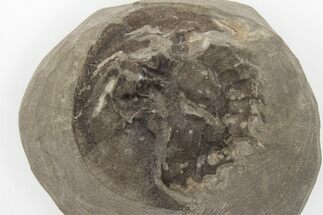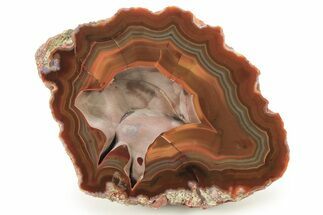This Specimen has been sold.
5.2" Cut/Polished Vivianite Nodule - Demons Bluff, Australia
This is a large half nodule of deep blue/green Vivianite which has been cut and polished. These Vivianite nodules are found at Demons Bluff near Anglesea, Australia, having washed ashore from submarine outcrops of black carbonaceous and pyritic Anglesea Sand Beds.
It's theorized that the Vivianite nodules from this location actually represent the trace fossils of crab burrows. The crab burrows filled up with debris and phosphate which under very specific conditions formed the Vivianite.
It's theorized that the Vivianite nodules from this location actually represent the trace fossils of crab burrows. The crab burrows filled up with debris and phosphate which under very specific conditions formed the Vivianite.
About Vivianite
Vivianite is a hydrous iron phosphate mineral that appears in flat, prismatic crystals. This mineral is highly sought after for its deep teal coloring and crisp translucence. It looks like a mystical glass that may be found in a fantasy movie. While it is commonly an iron phosphate mineral, occasionally the iron ion maybe substituted for magnesium, calcium, or manganese.
Even though it is prized for its color, it does not begin its existence in a glassy blue-green state. Vivianite is originally completely clear. However, when exposed to light, the crystals begin a chemical reaction, converting the iron(ii) ion into the iron(iii) ion. When this happens the mineral gradually shifts to a blue and then into a blue-green and keeps deepening in color until it is almost opaque black. Vivianite will color shift at different rates depending on the amount and intensity of the light it is exposed to. Therefore it is never truly stable, but as long as its exposure time is limited it should remain a consistent color for quite some time.
The highest quality vivianite crystals typically appear within hydrothermal veins. However, vivianite is occasionally found in association with fossils, especially lining the shells of bivalves or gastropods. A mummified steppe bison discovered in Alaska was coated in blue-green vivianite crystal oxidation, lending the specimen the nickname "Blue Babe".
Vivianite is a hydrous iron phosphate mineral that appears in flat, prismatic crystals. This mineral is highly sought after for its deep teal coloring and crisp translucence. It looks like a mystical glass that may be found in a fantasy movie. While it is commonly an iron phosphate mineral, occasionally the iron ion maybe substituted for magnesium, calcium, or manganese.
Even though it is prized for its color, it does not begin its existence in a glassy blue-green state. Vivianite is originally completely clear. However, when exposed to light, the crystals begin a chemical reaction, converting the iron(ii) ion into the iron(iii) ion. When this happens the mineral gradually shifts to a blue and then into a blue-green and keeps deepening in color until it is almost opaque black. Vivianite will color shift at different rates depending on the amount and intensity of the light it is exposed to. Therefore it is never truly stable, but as long as its exposure time is limited it should remain a consistent color for quite some time.
The highest quality vivianite crystals typically appear within hydrothermal veins. However, vivianite is occasionally found in association with fossils, especially lining the shells of bivalves or gastropods. A mummified steppe bison discovered in Alaska was coated in blue-green vivianite crystal oxidation, lending the specimen the nickname "Blue Babe".
SPECIES
Vivianite
LOCATION
Demons Bluff, Anglesea, Victoria, Australia
SIZE
5.2" wide,
CATEGORY
ITEM
#41507
 Reviews
Reviews













